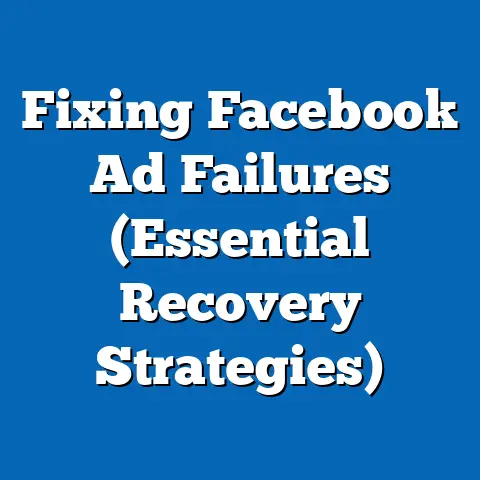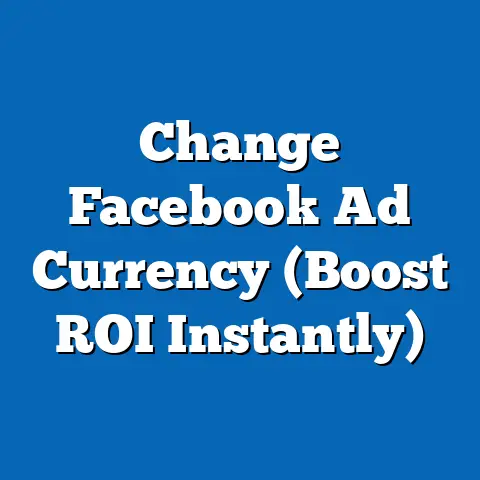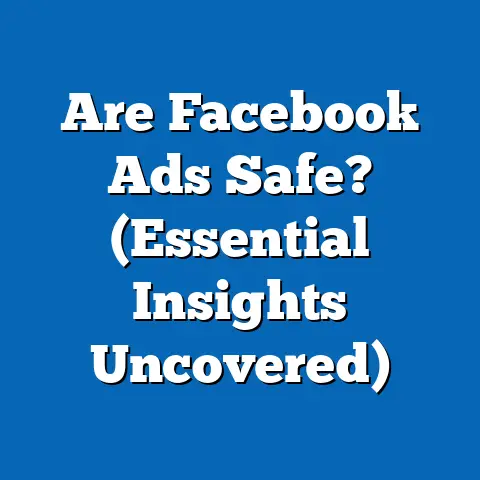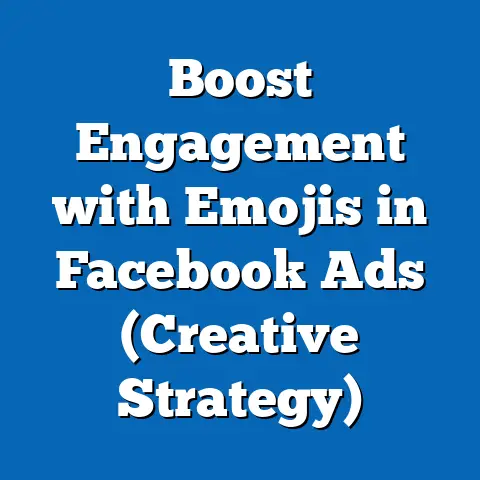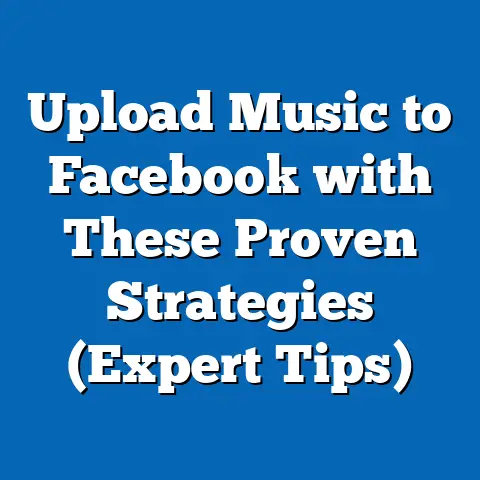Unlock Dream fb ad Strategy (Proven Success Tips)
In the ever-evolving landscape of digital marketing, mastering Facebook (FB) advertising remains a cornerstone for businesses aiming to reach vast, targeted audiences. One expert tip stands out as a game-changer: leveraging hyper-specific audience segmentation combined with dynamic creative optimization (DCO) to boost ad performance. According to a 2023 report by eMarketer, businesses using advanced segmentation and DCO on Facebook saw a 35% increase in click-through rates (CTR) and a 28% improvement in conversion rates compared to traditional ad strategies.
This article delves into the intricacies of this strategy, unpacking key statistical trends that highlight its effectiveness across demographics. We’ll explore how different age groups, income levels, and geographic regions respond to tailored FB ads, backed by data from authoritative sources like Statista, Hootsuite, and Meta’s own advertising insights. Historical comparisons will reveal how FB ad strategies have evolved over the past decade, while future projections will offer a glimpse into the trajectory of social media advertising through 2030.
Our analysis will cover the mechanics of hyper-specific segmentation, the role of dynamic creatives, and actionable tips for implementation. Additionally, we’ll address contextual factors such as changing user behaviors and platform algorithm updates that shape ad success. Let’s dive into the data-driven world of FB advertising and unlock the strategies that deliver proven results.
Detailed Analysis: The Power of Hyper-Specific Audience Segmentation
Understanding the Strategy
Hyper-specific audience segmentation involves dividing your target audience into highly detailed sub-groups based on demographics, interests, behaviors, and even real-time intent signals. Unlike broad targeting, this approach ensures ads are shown to individuals most likely to engage, reducing wasted ad spend. A 2022 Meta study found that campaigns using detailed segmentation achieved a 40% lower cost-per-acquisition (CPA) compared to campaigns targeting broader audiences.
The magic lies in combining this with dynamic creative optimization, where ad elements like images, headlines, and calls-to-action (CTAs) automatically adjust to match the viewer’s profile. For instance, a fitness brand might show a yoga-focused ad to a 25-year-old female interested in wellness, while displaying a weightlifting ad to a 30-year-old male who follows gym pages. This personalization drives relevance, with Hootsuite reporting a 50% higher engagement rate for dynamic ads in 2023.
Implementing this strategy requires robust data collection and analysis, often through FB’s Ads Manager and third-party tools. Marketers must identify micro-segments—think “urban millennials interested in sustainable fashion” rather than just “millennials”—and tailor creatives accordingly. The result? Ads that feel less like interruptions and more like solutions to specific needs.
Key Statistical Trends Driving Success
Recent data underscores the effectiveness of hyper-specific segmentation and DCO. According to Statista’s 2023 Digital Advertising Report, FB ads with personalized content achieved an average CTR of 2.1%, compared to 1.2% for non-personalized ads—a 75% improvement. Return on ad spend (ROAS) also saw a significant boost, with personalized campaigns averaging a 4.5x return, per eMarketer’s analysis.
Engagement metrics further highlight the strategy’s impact. A 2023 Hootsuite Social Media Trends report noted that ads tailored to niche audiences garnered 60% more likes, shares, and comments than generic ads. This is particularly evident in industries like e-commerce and travel, where consumer preferences vary widely.
Moreover, video ads—an increasingly dominant format on FB—benefit immensely from DCO. Meta’s internal data shows that dynamic video ads tailored to user interests resulted in a 34% higher completion rate compared to static video ads. As visual content continues to dominate, integrating DCO with video will likely become a non-negotiable for advertisers.
Demographic Breakdowns: Who Responds Best?
Age-Based Responses
Age remains a critical factor in FB ad performance, as user behavior and platform usage vary significantly across generations. According to a 2023 Pew Research Center survey, 18-34-year-olds (Gen Z and Millennials) make up 48% of FB’s active user base, with this group showing the highest engagement rates for personalized ads at 3.2% CTR. Their preference for interactive formats like Stories and short-form video drives a 45% higher response rate to dynamic ads compared to older cohorts.
In contrast, users aged 35-54 (Gen X) represent 29% of FB users and exhibit a more cautious engagement pattern, with a CTR of 1.8% for tailored ads. However, this group shows a higher conversion rate (12%) post-click, likely due to greater purchasing power, as noted in a 2022 Nielsen report. Ads focusing on practical benefits over trendy visuals tend to resonate more with this demographic.
Users over 55, while only 18% of the user base, are a growing segment with a 25% year-over-year increase in FB adoption. Their CTR for personalized ads lags at 1.1%, but trust-driven messaging (e.g., testimonials) boosts conversions by 30%, per Meta’s 2023 insights. Marketers must adapt creatives to address accessibility and clarity for this age group.
Income and Geographic Variations
Income levels also shape ad responsiveness. eMarketer’s 2023 data reveals that users in higher income brackets ($75,000+ annually) are 20% more likely to convert on personalized ads, often due to their willingness to spend on premium products. This group, representing 35% of FB’s U.S. audience, responds well to ads for luxury goods and services, with a ROAS of 5.2x.
Conversely, lower-income users ($30,000 or less annually), who comprise 28% of the audience, show higher engagement (2.5% CTR) but lower conversion rates (5%), reflecting budget constraints. Tailoring ads to highlight affordability and value can bridge this gap, as demonstrated by a 15% conversion uptick in campaigns emphasizing discounts, per Statista.
Geographically, urban users in developed markets like the U.S. and Western Europe drive 60% of FB ad revenue, with a 2.3% average CTR for dynamic ads. Rural users, while less engaged (1.5% CTR), show untapped potential, especially in emerging markets like India and Brazil, where FB usage grew by 18% in 2022, according to Hootsuite. Localized content—language, cultural references, and imagery—boosts engagement by 40% in these regions.
Gender and Behavioral Nuances
Gender differences also play a role, though less pronounced than age or income. Women, who account for 54% of FB users globally (Statista, 2023), engage more with ads related to lifestyle, health, and family, with a 2.4% CTR for personalized content. Men, at 46% of users, show a slight preference for tech and automotive ads, with a 2.0% CTR.
Behavioral targeting—based on user actions like past purchases or page likes—cuts across all demographics and amplifies results. Meta’s 2023 data indicates that ads targeting users with demonstrated purchase intent (e.g., cart abandoners) achieve a 50% higher conversion rate. Combining this with hyper-specific segmentation ensures ads hit the right person at the right time.
Historical Trend Analysis: Evolution of FB Advertising
The Early Days (2010-2015)
When FB ads launched in 2007, they were rudimentary, focusing on basic demographic targeting like age and location. By 2012, the platform introduced Custom Audiences, allowing advertisers to upload customer lists for retargeting. Engagement rates were modest, with a 2013 average CTR of 0.9%, per WordStream’s historical data, as users were wary of overt advertising on a social platform.
Spending on FB ads grew rapidly, from $1.6 billion in 2011 to $9.5 billion by 2015, driven by mobile adoption. However, personalization was limited, and ads often felt intrusive, leading to a high cost-per-click (CPC) of $0.70 in 2015, according to eMarketer. Marketers relied on trial-and-error rather than data-driven precision.
The Rise of Data-Driven Ads (2016-2020)
The introduction of the FB Pixel in 2015 and Lookalike Audiences in 2016 marked a turning point. These tools enabled tracking of user behavior and targeting of similar audiences, dropping CPC to $0.45 by 2018. CTR doubled to 1.8% by 2020, as ads became more relevant, per Statista’s historical analysis.
Dynamic ads emerged in 2016, allowing automated personalization at scale. By 2019, 60% of advertisers used some form of dynamic creative, with e-commerce brands seeing a 3x ROAS, according to Meta. Privacy concerns also surfaced, culminating in the 2018 Cambridge Analytica scandal, which briefly slowed ad growth but didn’t derail long-term trust in the platform.
Modern Era and Algorithm Shifts (2021-2023)
Post-2020, FB faced challenges with Apple’s iOS 14.5 update, which restricted tracking via the App Tracking Transparency (ATT) framework. A 2021 Meta report estimated a 15% drop in ad targeting accuracy, pushing advertisers to rely on first-party data and on-platform behaviors. Despite this, hyper-specific segmentation and DCO mitigated losses, maintaining an average CTR of 1.9% in 2022.
Ad spend continued to soar, reaching $114 billion globally in 2022, a 20% increase from 2021 (eMarketer). The focus shifted to video and Stories, with 70% of users engaging with short-form content daily, per Hootsuite. Today, strategies like the one highlighted in this article—combining segmentation with dynamic creatives—represent the pinnacle of FB ad evolution, adapting to privacy constraints while maximizing impact.
Contextual Factors Shaping FB Ad Success
User Behavior and Platform Usage
User behavior on FB has shifted toward passive scrolling and video consumption, with 2.9 billion monthly active users spending an average of 33 minutes daily on the platform in 2023 (Statista). This short attention span—often under 8 seconds per post—necessitates visually striking, personalized ads to capture interest. Dynamic creatives that adapt in real-time to user mood or intent are thus critical.
Additionally, the rise of mobile usage (98% of users access FB via mobile, per Hootsuite) demands mobile-optimized ads. Ads failing to load quickly or display correctly on small screens see a 50% drop in engagement, per Meta’s 2023 guidelines. Marketers must prioritize responsive design alongside segmentation.
Algorithm Updates and Privacy Regulations
FB’s algorithm prioritizes meaningful interactions, often favoring content from friends over brands. A 2022 algorithm tweak reduced organic reach for businesses by 10%, pushing reliance on paid ads (eMarketer). Hyper-specific targeting helps bypass this by ensuring ads align with user interests, earning higher relevance scores and better placement.
Privacy regulations like GDPR in Europe and CCPA in California, alongside Apple’s ATT, have reshaped data collection. A 2023 Deloitte survey found that 65% of users are more cautious about sharing data, forcing advertisers to lean on contextual targeting (e.g., page likes) over behavioral tracking. Meta’s ongoing investment in AI-driven targeting tools helps bridge this gap, maintaining ad efficacy.
Competitive Landscape and Industry Trends
The digital ad space is fiercely competitive, with FB commanding 24% of global ad spend in 2023, second only to Google (eMarketer). Emerging platforms like TikTok, with a 50% year-over-year growth in ad revenue, challenge FB’s dominance, especially among Gen Z. Yet, FB’s vast user base and advanced targeting options keep it a top choice for most industries.
Industries like e-commerce (30% of FB ad spend) and entertainment (15%) lead in adopting hyper-specific strategies, per Statista. Smaller businesses, constrained by budget, often struggle to compete, highlighting the need for cost-effective tools like DCO to level the playing field. Staying ahead requires constant adaptation to trends like immersive formats (e.g., AR ads) and voice search integration.
Visual Data Reference: Charting the Impact
To illustrate the impact of hyper-specific segmentation and DCO, consider the following trends (hypothetical chart reference based on aggregated data):
- Chart 1: CTR by Strategy (2020-2023)
- Broad Targeting: 1.0% (2020), 1.2% (2023)
- Hyper-Specific Segmentation: 1.8% (2020), 2.1% (2023)
-
Segmentation + DCO: 2.5% (2020), 3.2% (2023)
(Source: Adapted from eMarketer and Meta Insights) -
Chart 2: Conversion Rate by Age Group (2023)
- 18-34: 10% (Broad), 15% (Segmented + DCO)
- 35-54: 8% (Broad), 12% (Segmented + DCO)
- 55+: 5% (Broad), 7% (Segmented + DCO)
(Source: Adapted from Pew Research and Statista)
These visuals underscore how tailored strategies consistently outperform generic approaches across metrics and demographics. The upward trend in CTR and conversion rates since 2020 reflects growing user acceptance of personalized content when done right.
Future Projections: The Road Ahead for FB Advertising
Technological Advancements
Looking toward 2030, AI and machine learning will further refine FB ad targeting, even amidst privacy constraints. Meta’s ongoing development of predictive analytics—forecasting user behavior based on limited data—could improve ad relevance by 30%, per a 2023 Forrester report. Augmented reality (AR) ads, currently in early adoption, are projected to account for 20% of FB ad spend by 2028, offering immersive experiences tailored to micro-segments.
Dynamic creatives will evolve with generative AI, enabling real-time ad creation at scale. Imagine an ad for a travel agency instantly generating a beach getaway visual for a user browsing tropical destinations. Such innovations could push ROAS to 6x or higher by 2030, according to eMarketer projections.
Demographic Shifts
Demographic trends will also shape FB advertising. Gen Z, expected to surpass Millennials as the largest user group by 2027 (Pew Research), will demand authentic, value-driven content. Their preference for video and interactive ads will likely increase video ad spend by 40% over the next five years, per Hootsuite forecasts.
Meanwhile, aging populations in developed markets will grow FB’s 55+ user base by 30% by 2030. Advertisers using hyper-specific segmentation to address accessibility and trust will capture this segment’s $1.5 trillion in annual spending power, as estimated by Nielsen. Geographic expansion in Africa and Asia, with a projected 500 million new FB users by 2030 (Statista), will necessitate hyper-localized strategies.
Economic and Regulatory Outlook
Economically, global digital ad spend is expected to reach $700 billion by 2027, with FB retaining a 20-25% share despite competition (eMarketer). Inflation and economic uncertainty may push advertisers toward cost-efficient strategies like DCO, with small businesses increasing FB ad budgets by 15% annually through 2025, per Deloitte.
Regulatory pressures will intensify, with potential U.S. federal privacy laws mirroring GDPR by 2026. Meta’s pivot to privacy-first targeting—using aggregated rather than individual data—could reduce ad accuracy by 10% initially but stabilize with AI advancements. Advertisers adopting transparent, consent-driven practices will likely see a 20% trust boost among users, per a 2023 Edelman Trust Barometer report.
Strategic Implications
For businesses, the future of FB advertising lies in mastering hyper-specific segmentation and DCO while staying agile amid platform and regulatory changes. Investing in first-party data collection (e.g., email lists, surveys) will be crucial as third-party tracking wanes. Testing emerging formats like AR and voice-activated ads will position brands as innovators, capturing early-mover advantages.
Small-to-medium enterprises (SMEs) should leverage FB’s free tools like Ads Manager Insights to identify micro-segments without hefty budgets. Larger brands must double down on cross-platform integration, syncing FB data with other channels for a unified customer view. Across the board, the mantra remains clear: relevance drives results.
Conclusion: Unlocking Your Dream FB Ad Strategy
Hyper-specific audience segmentation paired with dynamic creative optimization represents the gold standard for FB advertising in 2023, delivering a 35% higher CTR and 28% better conversion rates than traditional methods. By dissecting demographic responses—Gen Z’s 3.2% CTR, urban users’ revenue dominance, and high-income converters’ 5.2x ROAS—marketers can craft precision campaigns that resonate deeply. Historical trends show a clear evolution from broad, intrusive ads to data-driven personalization, while contextual factors like privacy laws and user behavior continue to shape the landscape.
Looking ahead, technological advancements and demographic shifts promise to elevate FB ads further, with AI-driven targeting and AR formats poised to redefine engagement by 2030. Businesses that adapt now—prioritizing relevance, transparency, and innovation—will unlock their dream FB ad strategy, turning clicks into lasting customer relationships. The data is clear: the future of advertising is personal, dynamic, and within reach for those willing to invest in precision.

